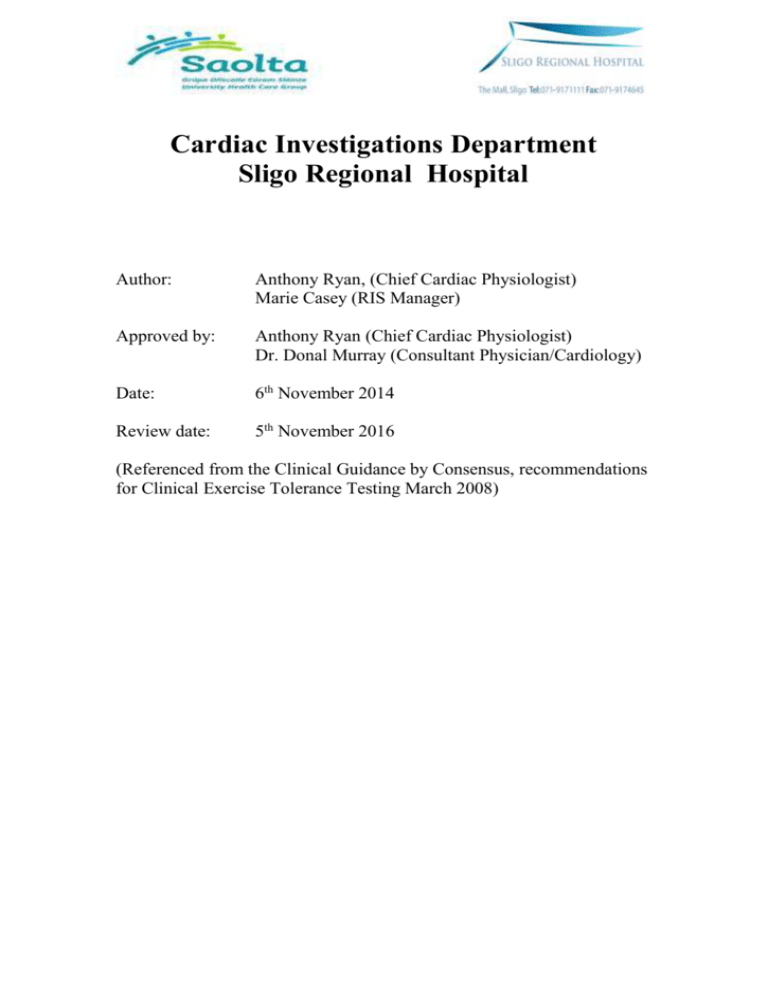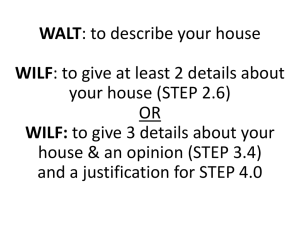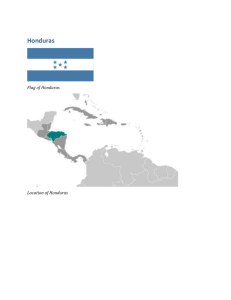Cardiac Investigations Department
advertisement

Cardiac Investigations Department Sligo Regional Hospital Author: Anthony Ryan, (Chief Cardiac Physiologist) Marie Casey (RIS Manager) Approved by: Anthony Ryan (Chief Cardiac Physiologist) Dr. Donal Murray (Consultant Physician/Cardiology) Date: 6th November 2014 Review date: 5th November 2016 (Referenced from the Clinical Guidance by Consensus, recommendations for Clinical Exercise Tolerance Testing March 2008) 1. Introduction This document aims to provide Health Care Professionals guidelines on referring patients for Exercise Stress Test. Clinical EST is an established non-invasive procedure that provides diagnostic and prognostic information for the evaluation of several pathologies, the most common of which is coronary heart disease. The EST does not provide detailed information on an individual’s capacity for dynamic exercise; other techniques, such as cardio-pulmonary exercise testing (CPX), exist for this purpose. To ensure the maximum effectiveness from the EST, it should be performed to national standards derived from current best practice. Although EST is considered a safe procedure, complications such as acute myocardial infarction and ventricular arrhythmias may occur. Whilst the statistical possibility of an adverse event is low the severity of the event outcome further highlights the importance of following nationally approved standards. The recommendations presented within this document are intended for use in any environment where an EST is required. These recommendations are not intended to apply to paediatric exercise testing, cardio-pulmonary exercise testing, pharmacological studies, or radionuclide studies. These investigations require further standards beyond the scope of this document. However the guidance presented in this document could provide useful information for these investigations . 2. Scope This guidance is aimed at clinical electrocardiography exercise tolerance testing for adult subjects. 3. Indications The indications for EST are presented in Table 1 below:Table 1 1. Diagnosis of coronary artery disease (CAD) in patients with chest pain that is atypical for myocardial ischaemia 2. Assessment of functional capacity and prognosis of patients with known CAD 3. Assessment of prognosis and functional capacity of patients with CAD soon after uncomplicated myocardial infarction (before hospital discharge or early after discharge) 4. Evaluation of patients with symptoms consistent with recurrent, exercise-induced cardiac arrhythmias 5. Assessment of functional capacity of selected patients with congenital or valvular heart disease 6. Evaluation of patients with rate-responsive pacemakers 7. Evaluation of asymptomatic men >40 years with special occupations (airline pilots, bus drivers, etc) 8. Evaluation of asymptomatic individuals >40 years with two or more risk factors for CAD 9. Evaluation of sedentary individuals (men >45 years and women >55 years) with two or more risk factors who plan to enter a vigorous exercise program 10. Assessment of functional capacity and response to therapy in patients with ischaemic heart disease or heart failure 11 Monitoring progress and safety in conjunction with rehabilitation after a cardiac event or surgical procedure 4. Patient Referral It is essential that only patients that are able to perform dynamic EST’s be referred to the Cardiac Investigations Department. Prior to low risk EST A physical examination and clinical history should be performed by a clinician with emphasis on excluding specific contradictions to low risk EST. Confirmation of the suitability for the investigation must be documented by completing the cardiac investigations request form. The request form must be signed and dated by the referring GP, along with Medical Council Number. If the indication for the EST is not clear then the form will be returned to the referring GP for further information. Clarification of low and high risk EST A low risk EST is classified as an EST that excludes the contraindications listed in Table 2 (Below), i.e. ‘low risk for an adverse cardiac event’. These listed conditions are not exhaustive and other conditions may be regarded as high risk. Such conditions are under the discretion of the Cardiac Physiologist and referring physician. Referrals that contravene these contraindications are regarded as high risk. All highrisk cases must be performed with an appropriately trained physician present (patients with a history of increasing or unstable angina or heart failure should not be exercised as low or high risk until their condition has stabilised). The physician’s role is to provide immediate clinical assessment of the patient and the administration of pharmacological therapies if required. It is important to note that the supervising Cardiac Physiologist has a duty of care, prior to starting the test to ensure that the patient can perform the EST safely. If the patient does not meet the criteria for the EST, the Cardiac Physiologist will postpone the EST until the reasons for postponement can be discussed with the referring GP. Table 2 –Contra-indications to low-risk exercise stress testing <1month post MI, post-PTCA/stent, postCABG Hg) ormalities that prevent ST analysis, (for example left bundle branch block) Any queries contact Cardiac Physiologist is unfamiliar with the requirements from the Licensing Authority •Raised Troponin level. •. Uncontrolled Heart Failure











